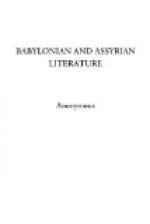[Footnote 6: The word means literally “pieces of strong wood.”]
INSCRIPTION OF NEBUCHADNEZZAR
TRANSLATED BY REV. J.M. RODWELL, M.A.
Babylonian inscriptions are by no means so replete with interest as the Assyrian. The latter embrace the various expeditions in which the Assyrian monarchs were engaged, and bring us into contact with the names and locality of rivers, cities, and mountain-ranges, with contemporary princes in Judea and elsewhere, and abound in details as to domestic habits, civil usages, and the implements and modes of warfare. But the Babylonian inscriptions refer mainly to the construction of temples, palaces, and other public buildings, and at the same time present especial difficulties in their numerous architectural terms which it is often impossible to translate with any certainty. They are, however, interesting as records of the piety and religious feelings of the sovereigns of Babylon, and as affording numerous topographical notices of that famous city; while the boastful language of the inscription will often remind the reader of Nebuchadnezzar’s words in Dan. iv. 30: “Is not this great Babylon, that I have built for the house of the kingdom, by the might of my power, and for the honor of my majesty?” Compare column vii, line 32.
The reign of Nebuchadnezzar extended from B.C. 604 to 561. In B.C. 598 he laid siege to Jerusalem (2 Kings xxiv.) and made Jehoiachin prisoner, and in 588 again captured the city, and carried Zedekiah, who had rebelled against him, captive to Babylon (2 Kings xxv.). Josephus gives an account of his expeditions against Tyre and Egypt, which are also mentioned with many details in Ezek. xxvii.-xxix.
The name Nebuchadnezzar, or more accurately Nebuchadrezzar (Jer. xxi. 2, 7, etc.), is derived from the Jewish Scriptures. But in the inscriptions it reads Nebo-kudurri-ussur, i.e., “may Nebo protect the crown”; a name analogous to that of his father Nebo(Nabu)-habal-ussur. ("Nebo protect the son”) and to that of Belshazzar, i.e., “Bel protect the prince.” The phonetic writing of Nebuchadnezzar is "An-pa-sa-du-sis," each of which syllables has been identified through the syllabaries. The word “kudurri” is probably the [Hebrew: kether] of Esther vi. 8, and the [Greek: kidaris] of the Greeks. The inscriptions of which a translation follows was found at Babylon by Sir Harford Jones Bridges, and now forms part of the India House Collection. It is engraved on a short column of black basalt, and is divided into ten columns, containing 619 lines.
It may be worth while to remark that in the name given to the prophet Daniel, Belteshazzar, i.e., Balat-su-ussur ("preserve thou his life"), and in Abednego ("servant of Nebo"), we have two of the component parts of the name of Nebuchadnezzar himself.




